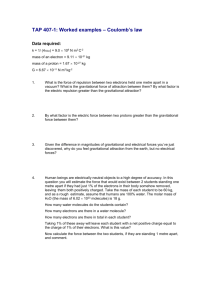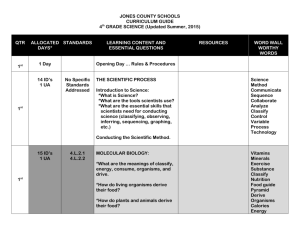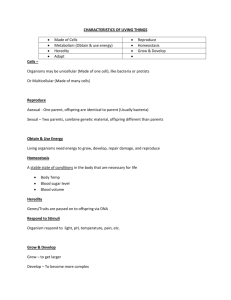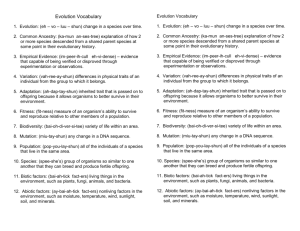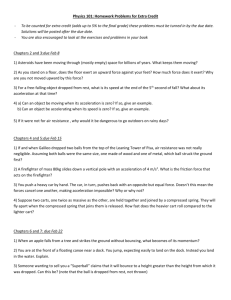Science Knowledge Audit Commentaries
advertisement
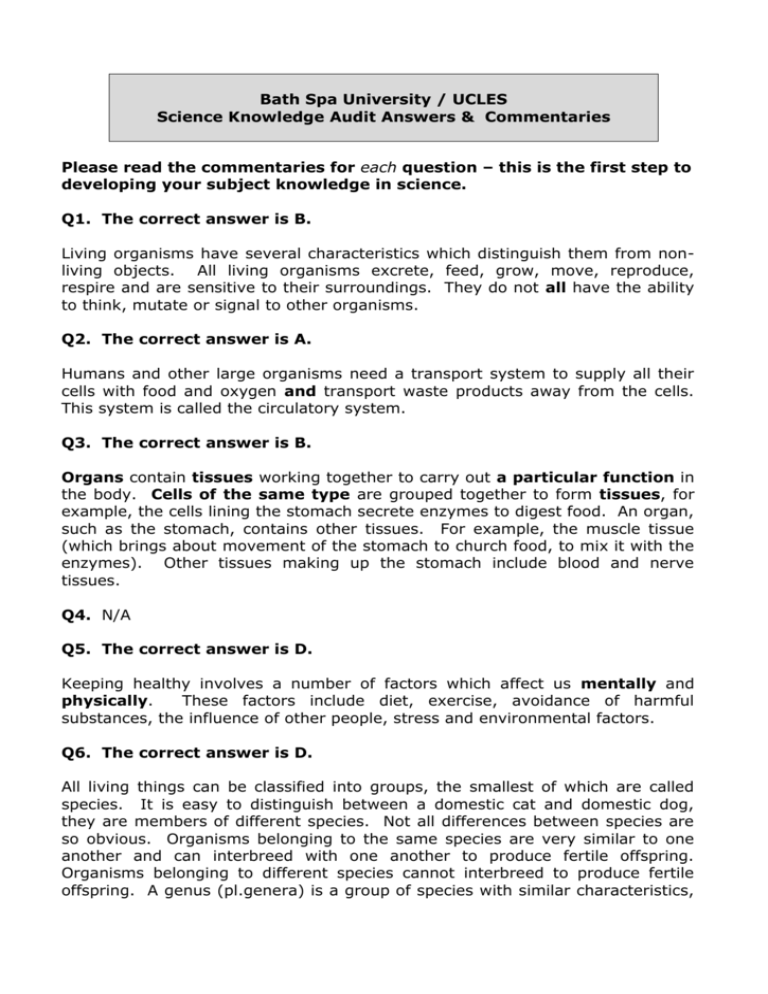
Bath Spa University / UCLES Science Knowledge Audit Answers & Commentaries Please read the commentaries for each question – this is the first step to developing your subject knowledge in science. Q1. The correct answer is B. Living organisms have several characteristics which distinguish them from nonliving objects. All living organisms excrete, feed, grow, move, reproduce, respire and are sensitive to their surroundings. They do not all have the ability to think, mutate or signal to other organisms. Q2. The correct answer is A. Humans and other large organisms need a transport system to supply all their cells with food and oxygen and transport waste products away from the cells. This system is called the circulatory system. Q3. The correct answer is B. Organs contain tissues working together to carry out a particular function in the body. Cells of the same type are grouped together to form tissues, for example, the cells lining the stomach secrete enzymes to digest food. An organ, such as the stomach, contains other tissues. For example, the muscle tissue (which brings about movement of the stomach to church food, to mix it with the enzymes). Other tissues making up the stomach include blood and nerve tissues. Q4. N/A Q5. The correct answer is D. Keeping healthy involves a number of factors which affect us mentally and physically. These factors include diet, exercise, avoidance of harmful substances, the influence of other people, stress and environmental factors. Q6. The correct answer is D. All living things can be classified into groups, the smallest of which are called species. It is easy to distinguish between a domestic cat and domestic dog, they are members of different species. Not all differences between species are so obvious. Organisms belonging to the same species are very similar to one another and can interbreed with one another to produce fertile offspring. Organisms belonging to different species cannot interbreed to produce fertile offspring. A genus (pl.genera) is a group of species with similar characteristics, for example, the wild cat and the domestic cat. A family is a group of genera with similar characteristics, for example, the cat family. A clone is an individual or a group of genetically identical individuals that have come from a single parent. Q7. The correct answer is D. The diagrams of two spot ladybirds show individuals of exactly the same size. They differ from one another only in the markings on the body. This is variation and may in time give rise to selection, for example, if certain markings on the body are advantageous in protecting the individual from predators. Q8. N/A Q9. The correct answer is D. In the nucleus of every cell there are chromosomes which contain genes. It is these genes that determine the characteristics of the organism, for example, eye and hair colour. For characteristics to be inherited genes must be passed from one generation to another. Mitosis is cell division which results in two new cells with exactly the same number and kinds of chromosomes, and therefore, the same genetic information as the original cell. Asexual reproduction involves only one parent; the offspring are produced by mitosis and are identical to the parent. Q10. N/A Q11. The correct answer is B. Least variation among offspring is as a result of asexual reproduction (cloning) which produces offspring which are identical to the parent. In sexual reproduction, genetic information from both parents is passed to the offspring, so the offspring will not be identical to either parent. Q12. The correct answer is B. Mutations of genes have led to beneficial changes. Darwin’s theory of evolution is based upon the idea that only organisms that are well adapted to their surroundings survive long enough to reproduce. Most mutations of genes are harmful, but some are beneficial leading to the development of organisms with improved characteristics. Q13. The correct answer is D. Classification means putting things into groups. Scientists now classify living organisms according to how closely related they are to one another. It is generally accepted that living organisms are classified into four kingdoms; animals, plants, fungi and bacteria. It is important to note that there is still some dispute within the scientific community with regard to the separation of plants and fungi. Q14. The correct answer is A. A habitat is where an organism lives, for example, in a pond. Within the pond there will be many different species of animals and plants making up the pond community. Q15. The correct answer is D. An ecosystem consists of a community and its environment. In a pond ecosystem there are interactions between all the living organisms, the pond water and the mud at the bottom of the pond. Q16. The correct answer is D. Bacteria are widespread and can survive in extreme conditions. Whilst some bacteria are harmful and cause disease, many play a vital role in the ecology of the Earth, particularly in the recycling of bioelements. Q17. N/A Q18. The correct answer is D. There are 109 known elements, including some recently made by scientists. All materials, including biological materials, are made up from these elements. The elements are arranged in the periodic table in order of increasing atomic power (number of protons in the nucleus). The periodic table is a source of names and symbols of the elements. Q19. The correct answer is C. When atoms of different elements combine together they form a compound. For example, two hydrogen atoms combine with one oxygen atom to form the compound water. The formula for water is H2O. Q20. The correct answer is B. The forces holding together atoms are called bonds. There are different types of bond; there are metallic (for example, iron), ionic (for example, sodium chloride) and covalent (for example, water). Q21. N/A Q22. The correct answer is B. Chemical reactions produce new substances and are usually difficult to reverse. When iron rusts, a new substance, iron (lll) oxide is produced. Ice can be reformed by freezing water. Salt can be recovered from salt solution by evaporation. The sugar crystals formed from a sugar solution will dissolve in water to reform the solution. Q23. The correct answer is D. Water evaporating is a physical change. The product is water vapour and this reforms as water on condensing. In all of the other cases new substances are produced. It is not possible to recover the ingredients in the cake, the unsoured milk or the un-burnt petrol. Q24. The correct answer is B. The question tells you that room temperature is 20°C. If you cool Q slightly below this temperature, the liquid will freeze. The state in which a substance exists depends upon temperature and sometimes also on pressure. There is no other substance with a melting point just below 20°C. Q25. The correct answer is A. Changes of state are accompanied by a transfer of energy. Melting and evaporating transfer energy in and freezing and condensing transfer energy out. In this question, ice and chocolate are melting and so gain energy. This energy is required to increase the energy of the particles. Q26. The correct answer is D. Eighteen centimetres cubed of water contains 600 000 000 000 000 000 000 000 or 6 x 1023 water molecules. Even one drop of water will contain millions of molecules (approximately 1021). (Remember, 1 million = 106.) It is hard to comprehend the large numbers involved here. Q27. The correct answer is C. When a liquid evaporates, the higher energy particles escape from the liquid’s surface. This can produce a cooling effect, for example, when alcohol evaporates from the back of the hand and the hand feels cold. Melting involves the breakdown of the solid structure into free moving particles. Q28. The correct answer is C. In this process, summarised by the equation, bonds are breaking between l – l and H-H, and new bonds are forming between H – l. Bond breaking requires energy and bond making produces energy. In this reaction more energy is released than is taken in. Q29. The correct answer is D. In any chemical or physical process the mass of the materials at the start is the same as the mass of the materials at the end. That is, unless some of the products are allowed to escape. For example, if a piece of wood is burned in oxygen, the mass of the wood and the oxygen is equal to the mass of the ash and the other gases produced. Q30. The correct answer is A. All matter, whether solid, liquid or gas, contains particles and these particles contain negatively charged electrons. A metal conducts electricity because some of the electrons are free to move through it whereas, in non-conductors, the movement of electrons is not apparent. Q31. The correct answer is A. Free electrons are able to move through a conductor and a metal is a good conductor of electricity. Electrons are not free to move in a poor conductor or insulator. Q32. The correct answer is A. The measure of the difficulty of free electrons passing through a conductor is called resistance. Resistance is measured in ohms (). A conductor with a high resistance is poor at allowing electrons to pass. Q33. The correct answer is C. A battery pushes electrons around a circuit in one direction. This movement of electrons is called current and is measured, using a ammeter, in amps (A). Current is a measure of the amount of charge that passes a given point in a set time. Note that, the passing of electrons is sometimes incorrectly called flowing (remember, charge flows but current passes). Q34. The correct answer is A. In a series circuit where each component is in a line, so electricity passes through each in turn, the current is the same at any point in the circuit. Electricity is not used up as the current passes round the circuit. This is a common misconception. Q35. The correct answer is B. The voltage is a measure of the energy per unit charge. It can be considered as driving the current round the circuit and is measured in volts (V). Q36. The correct answer is C. When a battery is used, the chemicals in the battery react to form energy. This stored energy is transferred to the circuit. The unit of stored energy is the joule. When the chemicals are used up, the battery can produce no more energy and is spent. Q37. The correct answer is A. Power is the rate of working or transferring energy. Power can be calculated as Power (watts) = energy transferred (joules) time (seconds) The distinction between power and energy transferred is often not understood. Power is a rate, i.e. it involves a quantity in unit time, as speed involves a distance travelled in unit time. Q38. The correct answer is C. When electricity passes through the fine wire of a filament of an electric light bulb, the moving electrons collide with the fixed atoms and they make the atoms vibrate more. This extra vibration causes the filament to become hot and emit light. Q39. The correct answer is A. Diagram A is a circuit diagram. The components are represented by standard symbols. Note especially the symbol of a cross inside a circle. This is the current symbol for a bulb or lamp. In diagram A, a battery, a switch and a bulb are connected in a series. The diagrams B, C and D represent similar circuits but use non-standard symbols. Q40. The correct answer is A. A bar magnet has a north pole at one end and a south pole at the other. When a bar magnet is suspended the north pole points northwards and is called the north seeking pole. This is used in a compass. When two bar magnets are brought close together, the north pole of one magnet is attracted to the south pole of another. The north pole of one magnet repels, or pushes away, the north pole of another. Q41. The correct answer is D. Magnets can exert forces over a distance. They do not have to be in contact. In the question, the iron nail is attracted to the magnet through the wooden table. The nail and the magnet do not have to be in contact. Q42. N/A Q43. The correct answer is A. This question is about the distinction between force and energy. A force is something which causes an object to speed up or slow down or to turn or to change shape. If you push a trolley, you are applying a force. An object standing on a table pushes downwards due to downward gravitational attraction (sometimes wrongly called gravity). This is balanced by an equal upward force from the table. The net result is a pair of balanced forces and no movement. Energy is needed when a force is applied. Here the weightlifter used some of his energy to apply a force to move the bar upwards. Q44. The correct answer is A. A fuel is a substance which is needed to produce energy. Apart from radioactive fuels, all fuels burn in oxygen (from the air) to produce waste products and release energy. This energy can be used to generate electricity. Common fuels include coal, oil and natural gas. Radioactive fuels, such as uranium, produce energy by radioactive decay and again the fuel is needed to do this. Electricity can be produced from solar energy (energy from the Sun), from magnetism or from water (hydroelectric power or waves) but these methods do not need a fuel. Q45. The correct answer is A. Energy transfers occur in chemistry (in all chemical reactions, for example, a burning candle) and in biology (in all biological processes, for example, walking) as well as in physics (for example, a radio playing). Q46. The correct answer is C. Energy can never be created or destroyed. All that can happen is that it is transferred into other kinds of energy. When an energy transfer takes place, such as when riding a bicycle, some of the energy involved is converted into less useful forms, such as sound, heat or friction. Q47. The correct answer is A. When anything is moving at a steady speed in a straight line, or is stationary, then the forces acting on it are balanced ones. When unbalances forces are acting upon it, it must be accelerating (increasing its speed), decelerating (decreasing its speed) or changing direction. Q48. The correct answer is A. After the child lets go of the ball, the forces acting on the ball are unbalanced ones. The ball falls to the ground because the downward gravitational force of the Earth (the ‘pull of gravity’) is greater than the upward force created by the air resistance. Q49. The correct answer is C. The downward force cannot move the sponge through the surface of the table. The force can only change the shape of the sponge by compressing it. Q50. The correct answer is B. The part of the boat under the surface of the water is affected by the resistance of the water. The part of the boat above the water is affected by air resistance. The force needed to move the boat is provided by the engine. This force is removed when the engine is switched off and the air resistance and water resistance then slow down the boat until it comes to a halt. Q51. The correct answer is C. There are frictional forces: (a) (b) between the tyres and the road, and between the wheels and their axles These frictional forces, together with the air resistance (also a frictional force), will slow down the movement of the pram. The person has to keep pushing to provide sufficient force to overcome the friction and the air resistance. Q52. The correct answer is B. The greater the friction between the tyres and the road, the better the tyres ‘grip’ the road. When there is water on the surface of the road, the amount of friction is reduced since the water acts as a lubricant. Therefore, the ‘grip’ under wet conditions is less and the wheels have a tendency to slip or skid. If slipping or skidding occurs, the car will not be able to move away as easily. Q53. The correct answer is A. The ‘Système International d’Unités’ (or Sl) is a ‘coherent’ system of measurement based on seven base units. Mass is one of these, and the unit of mass is known as the kilogram. All other scientific measurements are derived from these base units. The Sl unit of force is the Newton. Q54. The correct answer is B. All matter is made up of particles. These particles are packed together in different ways and the further apart these particles are the greater the amount of space the object takes up. The mass of an object is the amount of matter in it, irrespective of the distance between each of the particles. This is measured in grams and kilograms. The density of an object also depends on how the particles are packed together. Q55. The correct answer is D. Gravitational attraction takes between all bodies (not just heavenly bodies such as planets). The amount of gravitational attraction depends on the mass of the bodies and how far apart they are. Q56. The correct answer is C. The gravitational force caused by the Earth attracts the brick and this downwards force on its weight. The weight will change if the brick is in a different gravitational field (for example, on the Moon where the gravitational force is less than that of the Earth), but the mass of the brick is constant. Q57. The correct answer is C. The mass of the piece of rock remains the same wherever it is in the Universe. Its mass is determined by the amount of matter inside of it. Only the weight of the piece of rock will change because the gravitational force of the Earth is greater than that of the Moon. The rock will feel heavier, but will still have the same mass as it had on the Moon. Q58. The correct answer is B. Both the Moon and the Earth exert a gravitational force on objects. Because the Earth is much more massive than the Moon, the gravitational force is greater and consequently, the object feels heavier on the Earth because of this greater force. Q59. The correct answer is B. Because of the constant pull of gravitational force, all objects accelerate downwards at the same rate. On Earth, this effect is often not apparent because of the counter (upward) force of air resistance. Q60. The correct answer is D. The acceleration of a car is a measure of how fast it can change its speed. Both cars change their speed from 0 to 60 mph. The sports car gets from 0 to 60 in less time than it takes the saloon car. Therefore, the sports car changes its speed faster and has the better acceleration. Q61. The correct answer is B. Light always travels in straight lines and cannot pass through opaque objects. Light can only change direction if it is reflected (for example, from a mirror), refracted (for example, through a lens) or scattered (for example, from the surface of an object in its path). Q62. The correct answer is A. Different colours have different wavelengths. When sunlight is passed through a prism, the different wavelengths are refracted (‘bent’) by different amounts and the sunlight is split into the seven colours of the visible spectrum (red, orange, yellow, green, blue, indigo and violet). If all the light in sunlight had the same wavelength, all of it would be refracted by the same amount and rainbows would not occur. Q63. The correct answer is C. The smooth surface of the mirror allows the light to be reflected regularly and the rays of light form a clear image. Light is scattered from rough surfaces and not reflected in a regular fashion. Therefore, a clear image cannot be formed. Q64. The correct answer is B. When white light falls on the green T-shirt all the different wavelengths, except for the green, are absorbed by the material. The green which is scattered from the T-shirt, and which reaches our eyes, makes the shirt appear to be green. Q65. The correct answer is A. For us to see anything, light has to enter our eyes. We can only see objects when the light scattered from their surface reaches our eyes. Q66. The correct answer is C. All sounds are made when objects vibrate (for example, a drum skin or the metal of a bell). The vibrations produce sound waves which are transmitted through the air to our ears. Q67. The correct answer is B. The frequency of a sound depends on the number of vibrations every second. A large number of vibrations per second produce a high pitched sound, such as a whistle. A small number of vibrations produce a low pitched sound, like a ship’s hooter. Q68. The correct answer is C. Sound waves reach our ear drum. The waves make the ear drum vibrate and this movement is then converted into electrical signals which travel to the brain through the nerve cells. Q69. The correct answer is B. The Sun is a typical star of which there are many millions in our Galaxy. The Sun is at the centre of the Solar System, around which the planets revolve. The Sun only seems large because the Earth is relatively close to it. The other stars in our Galaxy are also suns but they are much further away from us. Some of these stars might have planets around them. Q70. The correct answer is A. The correct order of the planets, outwards from the Sun, is Mercury, Venus, Earth, Mars, Jupiter, Saturn, Uranus, Neptune and Pluto Q71. The correct answer is D. The Mood does not emit light, but only reflects the light which it received from the Sun. Therefore, only the side of the Moon facing the Sun is illuminated. As the Moon travels around the Earth during the course of a month we are able to see different fractions of this illuminated side. This is why the Moon seems to change shape regularly. Q72. The correct answer is D. The Earth rotates around its axis every twenty-four hours. This gives us night and day. However, this axis is tilted, but it always points in the same direction in space. The Earth rotates around the Sun every 365¼ days. At different times during this period, one hemisphere is sometimes tilted towards the Sun. This gives that hemisphere its summer. The other hemisphere is tilted away from the Sun and has its winter. Q73. The correct answer is B. The earth spins around on its own axis every twenty-four hours. Light from the Sun can only illuminate half the surface of the Earth, since it is a sphere. The half of the Earth which received light from the Sun has daytime. The other side, not receiving light, has night.

